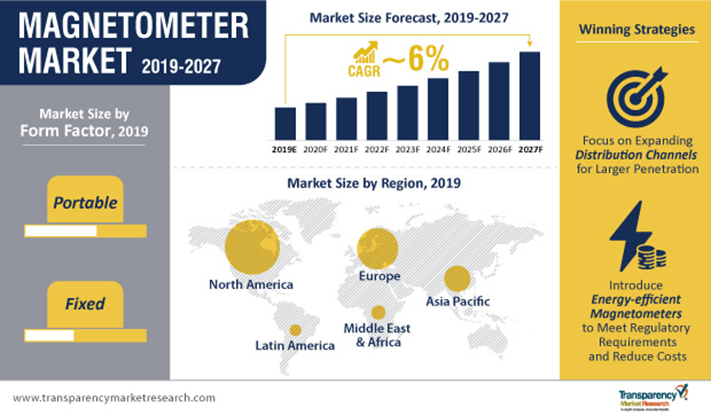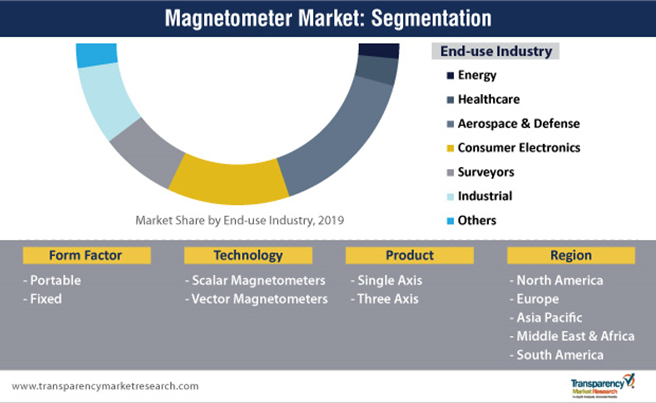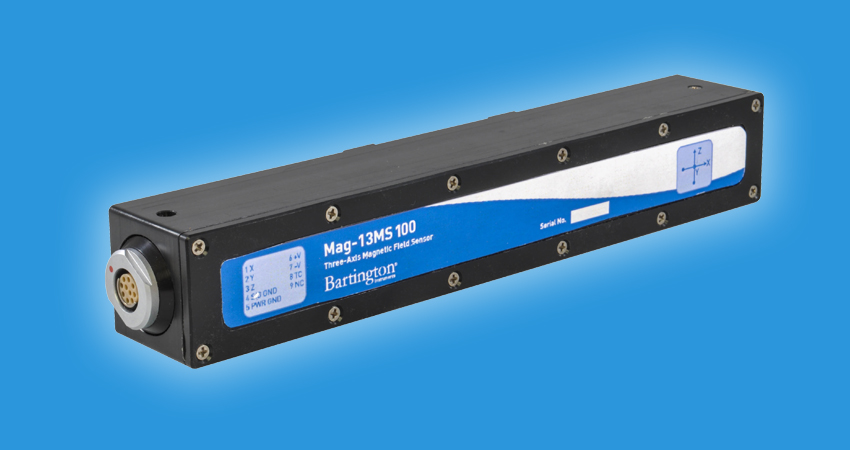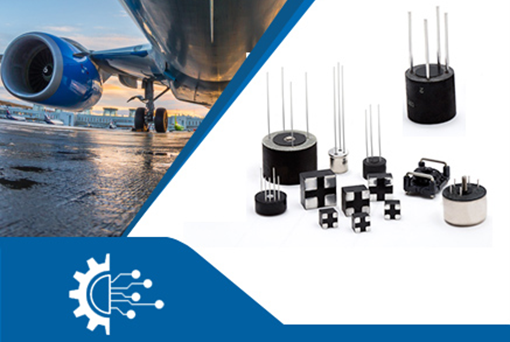
The global market for magnetometers is expected to reach $3 billion in sales in 2019 and continue climbing at about 6% annually to $4.7 billion over the next eight years, according to research by Transparency Market Research. New technologies and new uses such as in smart phones and tablets and in healthcare and aerospace industries are driving the continued growth, report the analysts in their study, “Magnetometer Market – Global Industry Analysis, Size, Share, Growth, Trends and Forecast, 2019-2017.”
Long hailed for its widespread use in scouring the Earth’s magnetic field, the adoption of magnetometers has effectively resonated in various industrial applications that involve geophysical surveys and detecting magnetic anomalies. With the ever-expanding range of industrial applications of magnetometers, end users are voicing demand for advancements in their features, such as improved sensitivity, accuracy, and precision.
With the advent of emerging technology, reports TMR, manufacturers in the magnetometer market are focusing on enhancing the quantum properties of atomic sensors to improve the sensitivity and speed of magnetometers, and ultimately improve their efficiency in industrial applications. Ongoing research and development in quantum technologies is expected to contribute toward improving the sensitivity and precision of magnetometry measurements, enabling market players to stand out in the competition with high-performance magnetometers.
The magnetometer market has gained momentum and its landscape is growing fast, says TMR, owing to the rapidly changing and dynamic environment that has promulgated their use for the detection of mineral deposits, coal exploration, and identifying precious archaeological artifacts, along with their inclusion in consumer electronics, healthcare and aerospace industries. Most of the content of this article is from TMR’s report summary which is available in full on their website.
The demand for magnetometers is likely to remain comparatively higher in developed regions such as North America and Europe, holding a formidable revenue share of the magnetometer market, and continuing their dominance especially in the area of consumer electronics. Though the market is likely to stabilize in the US and Canada, the market for magnetometers in Europe is growing at a fast rate. European countries including Germany, UK and France are expected to account for one-third revenue share of the global magnetometer market, mainly attributing to the presence of key market players, their penetrative reach across the region, and the heavy funding and investments done in the semiconductor and medical industries there.

Rising Demand for 3-Axis Magnetometers in Aerospace & Defense
Magnetometers are one of the most integral components used in the aviation industry and spacecraft telemetry for developing spacecraft magnetic cleanliness designs. The use of magnetometers in aviation is not restricted to Global Positioning System (GPS) monitoring and tracking, but also involves their application in Unmanned Aerial Vehicles (UAVs) for aerial mapping and investigation. These are some of the key trends that are boosting the sales of magnetometers in the aerospace industry.
The aerospace and defense industry generated over one-third of the total revenue of the global market for magnetometers in 2018, and this demand will only get amplified in the coming years. Ongoing advancements in technologies are enabling manufacturers to improve the performance characteristics of magnetometers to suit the specific requirements vis-à-vis their applications in the aviation and defense industries.
Aerospace and defense end-users are showing preference towards the adoption of three-axis magnetometers with unique variable permeability properties, along with excellent noise performance, high sensitivity, and good linearity. Leading stakeholders are likely to increase their focus on capturing the opportunities pertaining to the integration of magnetometers with UAV technology.
In addition, OEMs and magnetometer suppliers stand to hugely profit due to substantial investments in arenas such as crop monitoring, infrastructure inspection and accident analysis. Increasing use of drones in land mining, farming and construction will spearhead the sales of magnetometers in these industries, says TMR.
Dynamic Competitive Landscape Led by Bartington
The global magnetometer market is fragmented and witnessing an upsurge in competition, owing to rapid shifts and advancements in technology. Leading manufacturers of magnetometers such as Bartington Instruments Ltd, Cryogenic Ltd, Honeywell International Inc., and Gem Systems Advanced Magnetometers, account for about 30% revenue share of the magnetometer landscape with their robust collaborative strategies and penetrative distribution channels, reports TMR.
Ruling the roost is Bartington Instruments, a UK-based company displaying prowess in high precision magnetometers. A key behind its colossal global expansion is its vast distribution channel, with its arms reaching out across Europe and as far as Asia Pacific, say the TMR researchers. The company is a leading developer of sophisticated products for all major magnetometry markets.

In May 2019, Bartington re-launched the 3-axis Mag-13X fluxgate sensor with a temperature sensor and an electric shield that is designed to reduce emissions, thus making it more viable environmentally. Being used in bio-medicine and data storage, this re-launched product addresses the special needs of complex sensors in the consumer electronics and automotive industries. It is part of the company’s line of Mag-13 magnetometers, shown above is the Mag-13MS 100.

In September, a Bartington Spacemag magnetometer was scheduled to be launched into low Earth orbit, as part of UPM-SAT2 Union, a micro-satellite designed for academic and scientific applications. Created by a team at Universidad Politécnica de Madrid, the satellite was to be launched aboard a Vega rocket in French Guiana. Only a few months earlier, the Oculus-ASR satellite was launched from the Kennedy Space Center in Florida carrying Bartington’s Mag-03MRN 3-axis magnetometer, making it the largest satellite yet with a Bartington magnetometer aboard.
Standing second in market share, according to TMR, is Cryogenic. Headquartered in London with revenue of $12.8 million in 2018 and growing robustly, it has emerged as a leading market player due to its highly sensitive magnetometers. Its SQUID magnetometer has a very intricate internal design which keeps the magnet circuitry at a steady temperature, and makes it stand out in an intensely competitive market, says TMR.
Demand in electronics, healthcare and archeology Increasing
The demand for magnetometers has increased significantly across industries such as consumer electronics, healthcare and industrial archaeology, owing to the versatile roles they play in various industrial applications.
Technological breakthroughs such as the development of miniature optical magnetometers are driving future growth in healthcare, notes TMR. Human organs such as muscles, brain, heart and even a single nerve produce a magnetic field that can be measured by these magnetometers which can lead to resolving a myriad of health issues.
Wireless, wearable magnetometer-based sensors have changed the way sleep can be monitored. Transformative methods to detect the crucial sleep parameters of patients suffering from sleep apnea can be achieved by examining variations in the Earth’s magnetic field.
Magnetometers can provide turnkey solutions by their usage in cell phones and tablets. With their noise filtering capabilities, incredibly dynamic ranges and reduced power consumption, they will continue to find applications in the consumer electronics landscape in the coming years, says TMR.
Engineering Challenges Remain
As magnetometers are integrated into various devices and equipment, however, engineers continue to face challenges due to complexities in designing the features of magnetometers such as noise fluctuations, linearity, and sensitivity, caution the TMR analysts. Minor deviations in GPS that use magnetometers for forecasting natural disasters can give out error-prone and misleading information.
Temperature differences, and the presence of both soft and hard iron can lead to biases. A magnetometer reading can be distorted by ferromagnetic parts and associated electric equipment. In soft iron distortion, alternations or deflections arise in the existing magnetic field. If hard iron distortion occurs, such as from a speaker or magnetized piece of iron, it can result in permanent bias in the sensor output.
To see the complete summary and for more info about the report, go to www.transparencymarketresearch.com/magnetometer-market.html



